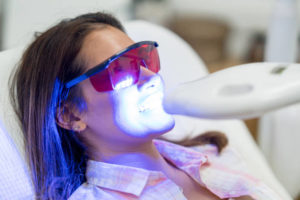How to Protect Gums during Teeth Whitening?
Whitening your teeth can make you feel good and more confident about yourself. However, it can also give you irritated or sensitive gums. The good news is that there are several steps that you can take to keep your gums protected during the teeth whitening procedure while minimizing discomfort and still ending up with a beautiful smile.
Visiting Your Dentist before Teeth Whitening
- Before you start your whitening treatment, see your dentist. They will give you a thorough examination, take x-rays and treat any dental problems you might have. You can get cavities filled, for example, to prevent pain and other compounded problems from the bleach. You also should get your teeth professionally cleaned. This way, your whitening treatment will turn out even more effective.
- Ask your dentist to recommend a teeth whitening treatment. After examining your teeth, the dentist can suggest the best method for your specific case. They can also recommend strategies and products to protect your gums. Whether you have extrinsic or intrinsic strains will dictate the best whitening treatment for you.
- To get the best results, follow the advice of your dentist. Your dentist might recommend that you get an in-office treatment where they will take care of your gums during the treatment. In such cases, they will use a strong solution with a laser to speed up the whitening process. Otherwise, they can recommend an at-home treatment like whitening strips of bleaching trays.
Using At-Home Teeth Whitening Treatments
- Go with custom-fitted trays if possible. If your dentist recommends bleaching trays, avoid those one size fits all trays. Most of them are bigger than your teeth, and the bleach ends up getting pressed against your gums, causing irritation. There are kits that allow you to make custom molds of your mouth, or just get your dentist to make them for you.
- Trim the strips to fit your teeth. Whitening strips are usually bigger than your teeth, so you can end up depositing the whitening solution to your gums. Before using the strips, hold them up to your teeth and trim off excess material as necessary.
- Apply desensitizing gel to your gums beforehand. Sensitive gums require a desensitizing gel before applying the teeth whitening product. You can ask for recommendations from your dentist, and make sure that you apply them as directed. Generally, a light layer of the gel is applied over the gums a few minutes before you start the whitening treatment.
- Remove the excess whitening solution from your gums. After applying the bleaching trays or strips, wipe off the excess gel from your gums using a tissue. This protects the gums from possible chemical burns and prevents the solution from irritating the gums.
- Leave the tray or strips only for the recommended amount of time. Never leave the bleaching trays or whitening strips longer than the directions suggest as this can lead to sensitivity or pain. Contrary to what many might believe, doing so will not make the teeth whiter. Carefully follow the instructions on the whitening kit.
Dealing with Tooth and Gum Sensitivity
- Use toothpaste made for sensitive gums and teeth. Generally, these products have potassium nitrate which works to desensitize the gums and teeth. If teeth whitening has caused you any level of sensitivity or pain, using these kinds of toothpaste can reduce irritation.
- Change to a weaker whitening agent. If your gums have become irritated, sore, and tender after your first whitening treatment, the solution may be too strong. Over-the-counter products generally have a carbamide concentration ranging from 10 to 20 percent. Switch to a lower concentration on your next whitening treatment.
- Avoid teeth whitening on sensitive gums. If your gums are sensitive or irritated, avoid the treatment until they completely heal. Doing so will protect both your teeth and your gums. After the sensitivity, irritation, and pain have healed, you can resume your teeth whitening treatments.
After whitening your teeth to their desirable shade, it is best that you do not continue to bleach them frequently as this can lead to the oversensitivity of your gums and teeth. Talk to your doctor to learn more about teeth whitening and how to protect your gums.
Summary

Article Name
How to Protect Gums during Teeth Whitening?
Description
Whitening your teeth can make you feel good and more confident about yourself. However, it can also give you irritated or sensitive gums. The good news is that there are several steps that you can take to keep your gums protected during the teeth whitening procedure while minimizing discomfort and still ending up with a beautiful smile.
Author
James Franklin
Publisher Name
D. Dental
Publisher Logo





 |
|